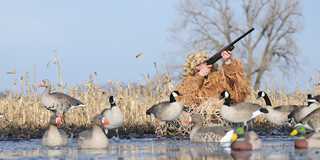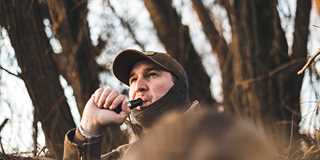Pro Tips for Winter Ducks
Fooling late-season ducks and geese often requires creativity, fresh approaches, and a little more work
Fooling late-season ducks and geese often requires creativity, fresh approaches, and a little more work

By David Hart
Theyve been in the area for weeks and are familiar with the territory. They know the location of every blind, have seen every decoy spread, and have heard every call note for note. They are stale birds, and they can be incredibly frustrating to hunt. What is a waterfowl hunter to do? Pray for some cold weather up north and a wave of fresh birds, of course. But as the season winds down, you dont have the luxury of waiting for new waterfowl to arrive. Now is the time to make the most of your opportunities. We asked several waterfowlers across the country to share some of their hard-earned secrets for hunting the wariest late-season ducks. Heres what they had to say.
Big spreads can be deadly on flight birds looking for company, but once waterfowl have been in the area for a while, they often break into smaller groups. This is especially true late in the season when many ducks begin pairing up for breeding, says Avian-X territory representative Curt Wilson, who hunts public land in Californias Central Valley. Thats why he pares down his spread as the season wears on.
I rarely use more than a dozen decoys when I know birds have been in the area a while, Wilson explains. Its just more realistic. It seems like everyone around me is using three or four dozen decoys.
Thats also what RigEm Right President Matthew Cagle sees in the areas he hunts along the North Carolina coast. A lot of waterfowlers just cant bring themselves to hunt with a half dozen decoys on a jerk string, but I do that all the time. It can work great. I usually dont pull in big flocks, but when the hunting is tough, you have to take what you can get, Cagle says.
Whether its a metal pit in a harvested rice field or an oak-brushed box blind in a forested swamp, late-season waterfowl know exactly what these structures mean. Add a hundred or so decoys that havent budged in weeks and its no wonder many birds wont come near a blind.
Thats why Brook Richard, corporate relations manager for Higdon Outdoors, abandons permanent blinds late in the waterfowl season. His strategy involves moving a hundred or more yards away from permanent blinds and hunting from less conspicuous mobile blinds or natural cover.
Ill grab two or three dozen of the best decoys from my permanent spread and drag them to the other side of the rice field, says Richard, who uses this tactic in eastern Arkansas. I dont pick up the decoys left around the pit blind, though. I want the birds to see them and think someone is hunting there. Those decoys act as a deterrent that can send birds to my side of the field.

Photo Jim Thompson
Hunters can also stand out from the crowd by setting a much larger spread than the competition, says Kevin Addy, an Avery pro-staffer based in southeastern Pennsylvania. Ten, 12, or even 15 dozen decoys can appear like a concentration of waterfowl on a refuge, or hungry birds competing for a prime food source. He says a supersized spread can be effective both on the water and in dry fields, but only when the conditions are right. For Addy, that means a light to moderate wind.
If there is no wind, a big spread will look even more unrealistic than a small one, Addy explains. Using motion decoys and jerk cords can help, but on calm days you are still going to have a bunch of decoys that are just sitting there, and the birds will avoid them.
Along with feeding, pair bonding, and escaping natural predators, one of the main interests of wintering waterfowl is avoiding hunters, and the birds often do this by taking refuge in inaccessible areas.
Ducks are going to find places where they can rest without being bothered, Addy says. In some cases, it can take an hour or more to reach these isolated spots, but its often well worth the effort. Ive hiked two miles to get to a beaver swamp that other hunters werent willing to walk to.
Even heavily hunted public areas can hold pockets of rested birds. Late-season ducks are remarkably good at hiding in plain sight. When I head back to the ramp, I often see ducks in places that I would never expect them to be, like on an open shoreline that doesnt seem to have anything that would attract ducks, Cagle says. Waterfowl use those spots as temporary refuges because they dont get hunted there. If you can find a way to hunt these areas, you can do really well.

Photo MICHAELFURTMAN.COM
Scouting is often essential for success when hunting late-season waterfowl, but what if you cant find any birds? Heavily hunted waterfowl often sit tight during the day and move mainly at night. Consequently, just because you dont see any birds doesnt necessarily mean they have left the area.
In response, Avery pro-staffer Jacob Wallace makes finding ducks a priority while he hunts. I often hunt for a few hours and then spend the rest of the morning scouting. I take advantage of all the time that I am allowed in the area to look for ducks, says Wallace, who is based in North Carolina. Im careful about avoiding other hunters, of course, but I mainly scout after most people have packed up and left.
Wallace and his hunting partners boat through flooded timber as far as they can and then spread out and scout on foot. I use binoculars to look for ripples on the water and ducks swimming ahead of me. The last thing I want to do is walk right into a bunch of resting birds. If you spook them, they may not come back. If I find some ducks, I back off, mark the location on a GPS, and hunt them the next morning, he says.
Most waterfowlers like to call, and aggressive calling can be highly effective when fresh flights of waterfowl have recently arrived in the area. But stale, late-season birds demand a different approach. Call to ducks, not at them, says Mike Anderson, an RNT pro-staffer and former world duck calling champion from Minnesota. Whats the difference? For Anderson, its a matter of timing and volume. You just have to watch the birds and see how they react. If they flare, Ill back off, but if they show interest, Ill keep it up, he says. I also dont call when ducks are coming toward me, because I dont want them to pinpoint my location. I want them looking at the decoys instead of at my blind.
Higdon marketing director Kelley Powers agrees. As a general rule, he calls only when birds are going away from him. When they turn back toward the decoys, he falls silent. They hear power calling all the time. You want to use more finesse when birds have been hunted hard, says Powers, who hunts the bottomlands of west Tennessee. When Im hunting stale birds, Im very careful when I call, and sometimes its best not to call at all.

Photo Seth Dortch
Spinning-wing decoys do a great job of increasing the visibility of a decoy spread, but waterfowl can learn to associate them with danger. Thats why Powers switches to random-action motion decoys late in the season.
Spinning-wing decoys arent necessarily a bad thing late in the season, but they need to offer something different from what the birds see all the time. I like a floating splasher/flasher decoy that runs intermittently. Higdons version of this decoy runs for a few seconds and then stops for several seconds before running again. It looks a lot more natural than a spinning-wing decoy that is running continuously while ducks are circling your spread, Powers says.
Using several spinners can also help give your spread a fresh look. Some hunters use five, six, and even a dozen spinners. Others mount them on poles of varying heights to look like a flock of ducks landing. When the birds have seen everything else, you can often be more successful by trying something different.

Photo Higdon Outdoors
Most waterfowlers dont have the luxury of resting the areas they hunt, but if you are fortunate enough to have access to private land or have found a secret honey hole on a public area, you can bag more birds by limiting how often you hunt there.
You can burn out a good area pretty quickly if you are hunting stale ducks, says Avery pro-staffer Kenny Gray. The longer you rest your hunting spots, the more birds are going to use them, which is why I dont hunt any of my blinds more than once a week. Sometimes I wont hunt a particular spot again until good numbers of birds are using it. The important thing is to give the birds enough time to rest between hunts.
Ducks Unlimited uses cookies to enhance your browsing experience, optimize site functionality, analyze traffic, and deliver personalized advertising through third parties. By continuing to use this site, you agree to our use of cookies. View Privacy Policy